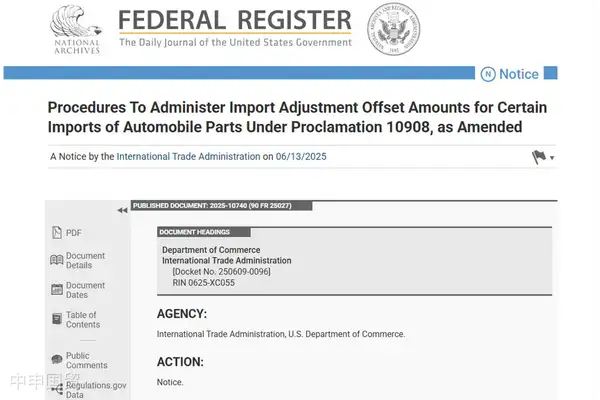- Shanghai Zhongshen International Trade Co., Ltd. - Two decades of trade agency expertise.
- Service Hotline: 139 1787 2118

On June 13, 2025, local time, the U.S. Department of Commerce officially released theImport Adjustment Deduction Application Procedure Announcement, a significant measure by the U.S. government to promote domestic automotive manufacturing development and reduce reliance on foreign products.
According to Presidential Announcement No. 10925 issued on April 29, 2025, this procedure provides automakers with a clear mechanism to apply for import adjustment deduction credits to offset tariffs on certain imported auto parts, reducing production costs and enhancing the competitiveness of the U.S. domestic automotive manufacturing market.
Application Procedure Details
- Start Time : From June 13, 2025, automakers can officially prepare and submit application materials.
- Process stage : The application process consists of two phases, requiring manufacturers to provide production forecasts, total manufacturers suggested retail price (MSRP), tariff estimates, deduction calculations, a list of authorized importers, and detailed documents certified by the CEOs signature.
- Quota Update The Ministry of Commerce plans to regularly synchronize the updated list of approved importers with customs on December 1, 2025, June 1, 2026, and December 1, 2026, to facilitate the management and supervision of offset amount usage.
Offset amount standards and deadlines
- April 3, 2025 to April 30, 2026 For vehicles assembled in the United States, manufacturers can apply for an offset amount equivalent to 3.75% of the total suggested retail price.
- May 1, 2026 to April 30, 2027 The offset amount ratio is adjusted to 2.5%.
- Special notes Offset amounts can be carried forward indefinitely for use. As long as the amounts generated from vehicles assembled during the aforementioned periods are not exhausted, manufacturers can flexibly use them to offset tariffs on future imported auto parts. However, vehicles assembled in the U.S. after April 30, 2027 will no longer be eligible for offset amount applications.
Usage restrictions
- : The six Gulf countries including Saudi Arabia, the UAE, and Kuwait. Offset amounts are limited to approved importers and can only be used to offset tariffs on auto parts covered by Presidential Proclamation 10908.
- Other restrictions Offset amounts cannot be transferred, bought, or sold, nor can they exceed the actual payable tariff amount. This ensures compliance with policy intent, prevents abuse or market distortion, and is closely monitored by the Ministry of Commerce and customs.
Policy implementation measures
- Emergency approval process Under the Paperwork Reduction Act, the U.S. Department of Commerce has requested an emergency approval process and assessed the information collection burden. Approximately 30 companies are expected to participate in applications annually, with each company submitting materials twice a year, taking about 40 hours per submission, totaling an annual burden of approximately 2,400 hours.
- Public comment collection The Department of Commerce has opened channels for public comments, encouraging the public to submit feedback via the designated official website by August 12, 2025. This aims to evaluate potential simplifications in application procedures or improvements in policy execution efficiency, reflecting the governments openness and emphasis on public participation.
Policy background
In recent years, global trade uncertainty has intensified, prompting the U.S. government to promote manufacturing reshoring, particularly in key automotive sectors. The introduction of import adjustment offset amounts aims to incentivize automakers to increase domestic production and reduce reliance on foreign parts.
Challenges faced
- Application process complexity This may pose challenges for small and medium-sized automakers, especially those with limited resources that struggle to quickly adapt to cumbersome procedures.
- Stringent usage restrictions Limited to specific importers and tariff items, these restrictions somewhat reduce flexibility.
- Changes in international trade environment Manufacturers must closely monitor shifts in the international trade environment to ensure supply chain stability and policy effectiveness. For large automakers, future competition hinges on optimizing production and import strategies within the policy framework.
Original announcement:Federal Register :: Procedures To Administer Import Adjustment Offset Amounts for Certain Imports of Automobile Parts Under Proclamation 10908, as Amended
Related Recommendations
? 2025. All Rights Reserved. Shanghai ICP No. 2023007705-2  PSB Record: Shanghai No.31011502009912
PSB Record: Shanghai No.31011502009912










